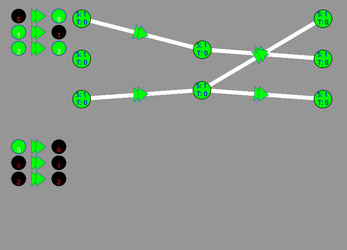Neurodoc
Neurodoc – Tutorial
Welcome to Neurodoc! In this game, you’ll build a neural network that must generate the correct combination of output values for each given set of input values. You can use intermediate neurons and connections (synapses) to design your network.
1. Overview: The Game Board
-
Left side: Here are the input neurons. They send signals into the network.
-
Right side: This is where the output neurons are, which produce the desired result.
-
Task cards: Located to the left of the input neurons. They show the input-output relationships your network must satisfy.
2. Basic Mechanics: Neurons and Synapses
What are neurons?
-
Each neuron has two states:
-
Active (black): The neuron sends a signal.
-
Inactive (green): The neuron does not send a signal.
-
-
A neuron becomes active when it receives enough signals from other neurons.
What are synapses?
-
Synapses connect neurons and transmit signals.
-
A signal travels through a synapse from the active neuron to the next one.
Getting started: Your first connection
-
Click the first input neuron.
-
Choose “New Synapse.”
-
Click the first output neuron to create the connection.
-
Press “Test Network” to see how the signal moves through the network. If successful, the output neuron will turn black.
3. Adding Intermediate Neurons
Sometimes a direct connection isn’t enough. That’s where intermediate neurons come in:
-
Click an existing neuron.
-
Select “Create New Neuron” and click where you want to place it.
-
It will automatically connect to the selected neuron.
-
-
Connect the new neuron to another target, such as an output neuron.
4. Tackling Challenges: Multiple Tasks at Once
-
Multiple task cards: To progress, your network must fulfill all tasks on the cards simultaneously.
-
Example: Activate input neurons 1 and 2. Check whether the correct output neurons are activated. Repeat this for every task combination.
-
-
If a test fails, you’ll need to adjust your network.
5. Advanced Mechanics: Thresholds and Negative Signals
Some tasks can’t be solved using only synapses and intermediate neurons. This is where thresholds and negative signals come into play.
Threshold (Activation Level)
-
The threshold value determines how many signals a neuron must receive to activate.
-
Default threshold: 1 (one signal is enough).
-
To increase the threshold:
-
Click a neuron.
-
Choose “Increase Threshold.”
-
The new value is shown on the neuron next to the letter T.
-
Example: A threshold of 2 means the neuron activates only when it receives at least two signals.
-
-
Negative Signals
-
Neurons can send negative signals to deactivate other neurons.
-
To decrease signal strength:
-
Click a neuron.
-
Select “Reduce Signal Strength” (click multiple times to lower it further).
-
A signal strength of -1 actively blocks the target neuron.
-
-
Tip: Use negative signals to resolve conflicts or deactivate specific neurons in your network.
6. Next Steps
-
Expand your network:
-
Add more intermediate neurons and adjust thresholds to solve complex tasks.
-
-
Test your network:
-
Use “Test Network” to check if your setup meets all requirements.
-
-
Optimize your design:
-
Can you make your network more efficient, using fewer neurons or connections?
-
Hints and Tips
-
Test frequently: Press “Test Network” often to catch mistakes early.
-
Experiment: There’s usually more than one way to solve a task. Try different strategies.
-
Plan ahead: Consider how future tasks might affect your current setup.
Good luck with Neurodoc!
Download
Click download now to get access to the following files:

Leave a comment
Log in with itch.io to leave a comment.